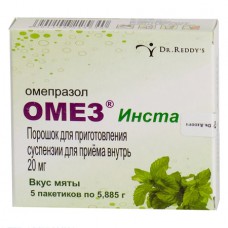Expiration date: 01/2026
Composition and form of release:
Powder for preparation of suspension for oral administration 1 pack.
omeprazole 20 mg
excipients: sodium bicarbonate — 1680 mg xylitol — 2000 mg sucrose — 2070 mg Sucralose — 30 mg, xanthan gum — 55 mg mint flavor — 30 mg
in bags made of combined material (low-density PE/aluminum foil/Low-density PE/Pergamin) 5, 885 g in a pack of cardboard 5, 10, 20 or 30 bags.
Description of the dosage form:
White to almost white powder with a mint smell.
Pharmacokinetics:
Absorption — high Tmax on average 30 min (10-90 min), bioavailability — 30-40% (with liver failure increases to almost 100%) with high lipophilicity, it easily penetrates the parietal cells of the stomach, binding to plasma proteins — 95% (albumin and acidic alpha-1-glycoprotein).
T1/2 is about 0, 5-1 h (in hepatic insufficiency — 3 h) total plasma Cl — from 0, 3 to 0, 6 l/min. Changes in the value of T1/2 during treatment do not occur.
Almost completely metabolized in the liver involving the enzyme cytochrome P450 (CYP), with the formation of six pharmacologically active metabolites (gidroksiomeprazol, sulphide and sulfonove derivatives, etc.). A significant part of the metabolism of omeprazole is dependent on the polymorphic expressed specific isoforms CYP2C19 (S-mephenytoin the hydroxylase), responsible for the formation of gidroksiomeprazol, the main plasma metabolite. It is a CYP2C19 inhibitor.
Excretion by the kidneys (70-80%) and with bile (20-30%). In chronic renal failure, excretion decreases in proportion to the decrease in creatinine clearance. In elderly patients, excretion decreases and bioavailability increases.
Description of pharmacological action:
Specific proton pump inhibitor: inhibits the activity of H+-K+-ATPase in the parietal cells of the stomach, blocking the final stage of hydrochloric acid secretion, thereby reducing acid production.
Omeprazole is a prodrug and is activated in the acidic environment of the secretory tubules of the parietal cells of the stomach.
The effect is dose-dependent and provides effective inhibition of both basal and stimulated acid secretion, regardless of the nature of the stimulating factor.
Elimination of heartburn after taking the drug occurs within 30 minutes. Inhibition of 50% of the maximum secretion of hydrochloric acid continues for 24 hours.
A single dose per day provides rapid and effective suppression of day and night gastric secretion, which reaches its maximum after 4 days of treatment and disappears by the end of 3-4 days after the end of the reception. In patients with duodenal ulcer, 20 mg of omeprazole maintains an intragastric pH above 3 for 17 hours.
Indications:
- heartburn and other symptoms associated with gastroesophageal reflux disease (GERD)
- non-erosive and erosive (reflux esophagitis) forms of GERD
- peptic ulcer of the stomach and duodenum (including prevention of relapses)
- eradication of Helicobacter pylori in infected patients with gastric and duodenal ulcer (as part of combination therapy)
- NSAIDs-gastropathy
- hypersecretory conditions (Zollinger-Ellison syndrome, gastrointestinal stress ulcers, polyendocrine adenomatosis, systemic mastocytosis).
Contraindications:
- hypersensitivity
- fructose intolerance
- sucrose/isomaltase deficiency
- glucose-galactose malabsorption (due to the presence of sucrose in the preparation)
- children's age
- pregnancy
- lactation period.
The drug should not be used in conjunction with atazanavir and nelfinavir.
With caution — kidney and/or liver failure.
Side effect:
In rare cases, the following, usually reversible, adverse reactions may occur.
The frequency of side effects is classified according to the frequency of occurrence of the case: very often (&,ge1/10), often (from &,ge1/100 to <,1 10="" ge1="" 1000="" 1="" 100="" 10000="" p="">,
From the hematopoietic organs: rarely — leukopenia, thrombocytopenia very rarely — agranulocytosis, pancytopenia.
From the digestive system: often — diarrhea or constipation, abdominal pain, nausea, vomiting, flatulence rarely — increased activity of liver enzymes, taste disorders very rarely — dry mouth, stomatitis, candidiasis of the gastrointestinal mucosa in patients with previous severe liver disease — hepatitis (including jaundice) very rarely — liver failure, including with the development of encephalopathy (in patients with a history of liver diseases).
From the nervous system: often — headache, infrequently — dizziness, paresthesia, drowsiness rarely — taste disorders.
Mental disorders: infrequently — insomnia rarely — agitation, confusion, depression very rarely — aggression, hallucinations.
From the sensory organs: rarely, vertigo, rarely — blurred vision.
From the musculoskeletal system: rarely — arthralgia, myalgia very rarely — muscle weakness.
From the skin: infrequently — dermatitis, itching, rash, urticaria rarely — alopecia, photosensitization very rarely — multiform exudative erythema, Stevens-Johnson syndrome, toxic epidermal necrolysis.
Allergic reactions: rarely — hypersensitivity reactions, including fever, angioedema and anaphylactic reactions (including anaphylactic shock).
From the genitourinary and reproductive system: rarely — interstitial nephritis very rarely — gynecomastia.
Metabolic disorders: rarely — hyponatremia very rarely — hypomagnesemia.
Other: infrequently — malaise, peripheral edema rarely — bronchospasm, increased sweating.
Drug interaction:
Due to a decrease in the acidity of gastric juice during treatment with omeprazole, the absorption of other drugs may decrease or increase, the absorption mechanism of which depends on the pH of gastric juice.
Reduces the absorption of ketoconazole and Itraconazole.
Increases absorption of digoxin. The combined use of omeprazole at a dose of 20 mg once a day and digoxin increases the bioavailability of digoxin by about 10%.
Omeprazole has been shown to interact with some antiretroviral drugs.
The mechanisms and clinical significance of these interactions are not always known. Increased pH in the stomach during omeprazole therapy may affect the absorption of antiretroviral drugs.
It is also possible to interact at the SUR2C19 level. With the combined use of omeprazole and antiretroviral drugs, such as atazanavir and nelfinavir, against the background of therapy with omeprazole, there is a decrease in their concentration in serum. In this regard, the combined use of omeprazole with antiretroviral drugs such as atazanavir and nelfinavir is not recommended.
With the simultaneous use of omeprazole and saquinavir, an increase in the concentration of saquinavir in the blood serum was noted.
Omeprazole inhibits CYP2C19, the main isoenzyme involved in its metabolism.
The combined use of omeprazole with other drugs that CYP2C19 participates in the metabolism, such as diazepam, phenytoin, warfarin, other vitamin K antagonists, and Cilostazol, may lead to a decrease in the metabolism of these drugs.
It is recommended to monitor the concentration of phenytoin in plasma with the simultaneous use of phenytoin and omeprazole in some cases, it may be necessary to reduce the dose of phenytoin. At the same time, in patients taking phenytoin for a long time, the combined use of omeprazole at a dose of 20 mg once a day did not cause changes in the concentration of phenytoin in blood plasma.
When using omeprazole in patients receiving warfarin or other vitamin K antagonists, INR control is necessary in some cases, it may be necessary to reduce the dose of warfarin or another vitamin K antagonist. At the same time, in patients taking warfarin for a long time, co-administration of omeprazole at a dose of 20 mg once a day did not cause changes in clotting time.
The use of omeprazole at a dose of 40 mg once a day led to an increase in Cmax and AUC of Cilostazol by 18 and 26%, respectively, for one of the active metabolites of Cilostazol, the increase was 29 and 69%, respectively.
Omeprazole does not affect the metabolism of drugs that are metabolized by CYP3A4, such as cyclosporine, lidocaine, quinidine, estradiol, erythromycin and budesonide.
With the simultaneous use of omeprazole and tacrolimus, an increase in the concentration of tacrolimus in the blood serum was noted.
In the metabolism of omeprazole by CYP2C19 and CYP3A4 are involved. The combined use of omeprazole and CYP2C19 and CYP3A4 inhibitors, such as clarithromycin and voriconazole, may lead to an increase in the concentration of omeprazole in blood plasma by slowing the metabolism of omeprazole. The combined use of voriconazole and omeprazole resulted in more than a twofold increase in the AUC of omeprazole, which, however, did not require correction of the dose of omeprazole.
Drugs that induce CYP2C19 and CYP3A4, such as rifampicin and preparations of St. John's wort, when used together with omeprazole can lead to a decrease in the concentration of omeprazole in the blood plasma by accelerating the metabolism of omeprazole.
Dosage and administration:
Inside, 30 minutes before meals. Pour the contents of the bag into a Cup, add 1-2 tablespoons of water (do not use other liquids or food products!), stir thoroughly until a homogeneous suspension is obtained and drink immediately. If necessary, you can drink a small amount of water.
For rapid relief of heartburn symptoms, a single dose of 20 mg of the drug is sufficient.
Patients with non — erosive GERD-20 mg once a day for 4 weeks.
Patients with erosive GERD (reflux esophagitis)-20 mg 2 times a day for 4-8 weeks, depending on the severity of esophagitis.
To prevent exacerbation of reflux esophagitis-20 mg/day, the duration of maintenance therapy is determined individually.
In case of exacerbation of gastric ulcer or duodenal ulcer, not associated with Helicobacter pylori — 20 mg in the morning 1 time a day for 4-8 weeks.
For eradication of Helicobacter pylori, therapy is used in various combinations: for 7-14 days, omeprazole 20 mg, amoxicillin 1 g, clarithromycin 500 mg — 2 times a day or omeprazole 20 mg, clarithromycin 500 mg, metronidazole 500 mg — 2 times a day or omeprazole 20 mg — 2 times a day, bismuth preparations at a dose of 120 mg — 4 times a day, metronidazole 500 mg — 3 once a day and tetracycline 500 mg — 4 times a day.
For the prevention of gastric ulcer or duodenal ulcer — 20 mg in the morning 1 time a day for 4-8 weeks.
For the treatment of NSAID-gastropathies — 20 mg 2 times a day for 4-6 weeks, for prevention — 20 mg per day for the period of NSAID use in patients with risk factors for the development of NSAID-gastropathy.
In hypersecretory conditions — 20 mg in the morning 1 time a day for 4-8 weeks.
In the treatment of Zollinger-Ellison syndrome, doses are selected individually, depending on the clinical condition. The recommended starting dose is 60 mg/day. In most patients, the condition is adequately controlled in the dose range of 20-120 mg. If you need to use a dose of more than 80 mg, it is necessary to divide it into 2 injections.
In elderly patients and with renal insufficiency, there is no need to adjust the dose. In case of liver failure, a daily dose of 20 mg may be sufficient.
Overdose:
Symptoms: headache, dizziness, lethargy, confusion, tachycardia, arrhythmia, blurred vision, drowsiness, dry mouth, nausea, vomiting, flatulence.
Treatment: symptomatic. If necessary, gastric lavage, activated charcoal. Hemodialysis is not effective enough.
Special instructions:
Before starting therapy, it is necessary to exclude the presence of a malignant process (especially with stomach ulcers), because treatment, masking the symptoms, can delay the correct diagnosis.
Taking it simultaneously with food does not affect its effectiveness.
Impact on driving and using other equipment
Omez Insta does Not affect the ability to drive vehicles and work with mechanisms.
Due to the fact that dizziness and drowsiness may occur during therapy with Omez Insta, care should be taken when driving vehicles and other mechanisms.


